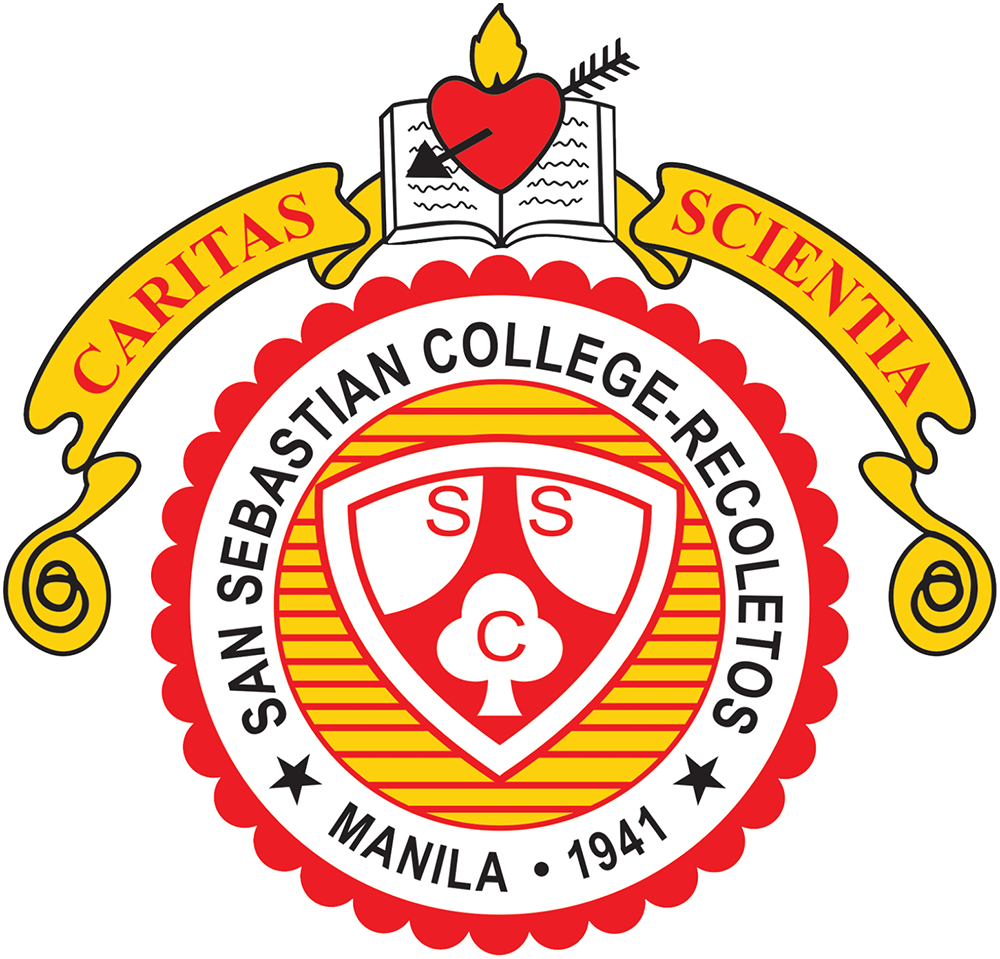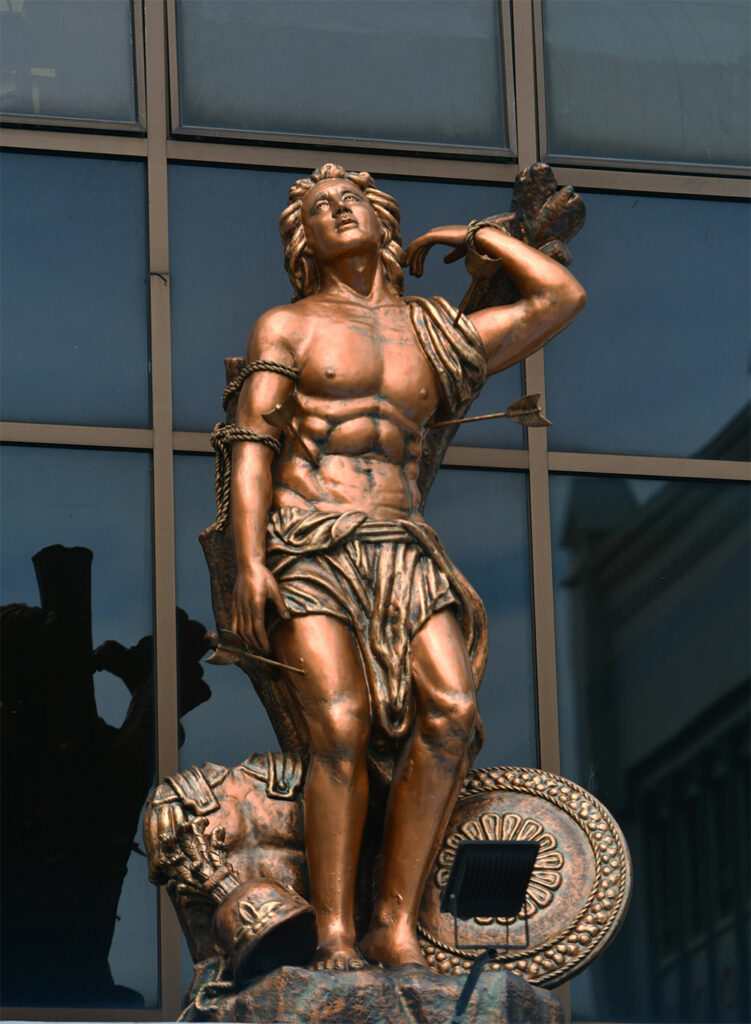SSC-R SEAL
The SSC-R Manila Logo

The logo of SSC-R Manila is traceable to a Marian, and more concretely, Carmelite origin. The College originated as an extension of the evangelization work of the Augustinian Recollect fathers, which work, since the 17th century, had as its center the nearby church of San Sebastian. The church is the first shrine of Our Lady of Mt. Carmel, for in it was enshrined, in 1621, the Marian image brought to the Philippines from Mexico in 1618. Thus, from church to school, names and symbols made an easy transition.
When the school was formally opened and a logo was needed, the academic must have taken inspiration basically from the Carmelite coat of arms, adding to its symbols of Augustinian significance.
SSC-R Manila Coat of Arms
The Coat of Arms, adapted from the Carmelite coat of arms, features a heraldic shield wherein are contained a mountain, a cross and three stars, as can be seen at the feet of the bas-relief of Our Lady of Mount Carmel on the façade of the basilica.
The mountain represents Mount Carmel where the prophet Elijah courageously witnessed to the true God; the cross on top; and the two stars above, according to one interpretation, represent Christ and Mary, while the lower star represents Elijah.
The artist who designed the logo placed the heraldic shield within a circle and substituted the stars with the initials of the institution (SSC), placing the C within a clover.
The outer circle bordered by wavy lines symbolizes unity of the school community amidst the restlessness of the heart’s pilgrimage, a heart that finds rest only in God (cf. Confessions I, 1.1).
The inner circle shadowed by straight lines symbolizes our search for interiority, which is the essence of the Recollect identity; the search is at once imperative and difficult, given the temptation, increasingly greater at present, for one to be dissipated in external things.
The placement of the letter C of the initials SSC inside a clover – since the early Church a symbol of the Trinity – expresses the institution’s avowed aim to place at the center of its life and work the Triune God, the only true foundation and the protector of the interior man and of the community.
The flaming heart pierced by an arrow with a book in the background at the center of the banner bearing the words “Caritas et Scientia” point to the Augustinian character of the institution.
The flame represents human restlessness. St. Augustine says, we are restless pilgrims whose hearts remain restless until they rest in God. The book symbolizes the scriptures and strict adherence to the teaching and the authority of the Church.
The symbol challenges every Sebastinian to be like St. Augustine to go back to the heart and listen to the Word of God and find refuge in the teaching of the mother Church remembering that the heart is restless until it rest in God.
Caritas et Scientia
SAN SEBASTIAN

St. Sebastian was martyred in 288 A.D. and his feast day is celebrated on January 20th.
He was a trusted Roman soldier, a faithful Christian in the midst of the paganistic Roman military.
According to his legend, he was born in Gaul, went to Rome, and joined the Roman army in 283A.D., ostensibly to be of service to other Christians who were being persecuted by the Romans. Because of his courage he became one of the captains of the Praetorian Guards under Diocletian and Maximian, who were unaware that he was a Christian.
The emperor, Diocletian, hated all Christians and ordered many to be tortured and killed. Amidst the persecution, St. Sebastian encouraged the Christians to be faithful and strong to their faith, visited those who were imprisoned, bringing them supplies and comfort. St. Sebastian also converted many soldiers, several other prominent individuals, including the local prefect.
St. Sebastian was discovered as a Christian and was reported to the Emperor Diocletian. The Emperor scolded Sebastian and ordered him to be killed by arrows.
Archers riddled his body with arrows, his body was described as, “full of arrows as an urchin.” Believed to be dead, the archers left his body for retrieval and burial. Miraculously, the arrows did not kill him.
A Christian widow named Irene came to retrieve his body to bury it, and seeing that he was still alive, nursed him back to health.
Once well, Sebastian went in search of Diocletian and proceeded to criticize him loudly and publicly for his cruelties against Christians. Diocletian ordered his former guard to be beaten to death with clubs, then thrown into the common sewer.
His body was recovered by a pious lady, named Lucina, and she secretly buried him in the catacombs beneath Rome.
St. Sebastian’s story is one of courage, dedication, and strength.
St. Sebastian is the patron saint of soldiers, athletes, and those who desire a saintly death.
San Sebastian also represents the value of silent hard work. Like him, every Sebastinian should manifest the virtue of working hard without the need to tell everybody of what he has done or accomplished. Lastly, every Sebastinian true to the saint must continue to safeguard his faith especially in the midst of a consumeristic society. As one write-up aptly states: “Live thy, as Christian among pagans… unyielding to the demands of the world… strong and steadfast in whatever kind: suffer for thy faith… derision and exclusion from society enjoyment… if such be necessary to confess in word and deed…”
RECOLETOS
The term “Recoletos” is a shortened form of “Agustinos Recoletos” (Augustinian Recollects) and, in Philippine Christian history, has been the more habitually used term, to distinguish them from the Agustinos (Augustinians). The Augustinian Recollects originated as a reform movement in 16th century that emphasized fidelity to the Rule of St. Augustine, especially in the areas of community prayer and simplicity of life and aimed for a more austere way of life. In 1606, the first Recoletos missionaries came to the Philippines.
The Order of Augustinian Recollects (OAR) Constitutions state that the Order has a three-fold character, namely: Contemplative (Ch.1, art. 2), Communitarian (Ch. 1, art. 3) and Apostolic (Ch.1, art. 4), and presents Mary as “model of perfection for all consecrated persons” (Ch. 1, art. 5, n. 29).
For the constituents of San Sebastian College, Manila, to be contemplative means having an intimate and personal experience of the Creator, whatever one’s state of life may be. Through contemplation, one embraces God and is embraced by him (cf. De Trin. 8,12); one’s inner life is built by God (cf. En. Ps., 126,2); and one has confidence in God: “I belong to the Omnipotent in such a manner […] that He enlightens me and save me, and I fear no one outside of Him” (En. Ps. 26,3).
The essence of love is to be communicated and disseminated; this action is the apostolate (cf. OAR Const. 23). The more contemplative and communitarian a person is the more desirous he/she is to share the knowledge and experience of God among the fellowmen. The Blessed Virgin Mary is the model for the contemplative, communitarian and apostolic life.
Additionally, Augustinian Recollects, especially in the Philippines, also look to Saint Ezekiel Moreno, who spent 15 years among Filipinos, as the personification of the Recoletos charism.
THE STAG
The use of the stag as SSC-R symbol started when SSC-R, originally an exclusive school for boys, joined the National Collegiate Athletic Association. In religion, the stag is a symbol of moral ideals. It was used by the early Christians as an emblem of Christ and as a figure of the apostles. It became the symbol of administration of baptism because of its capacity to carry heavy load or object. It was also used as the symbol of the catechumen who aspired for martyrdom.
Some of the Holy Fathers presented the Stags as model of what a Christian should do when a pagan threatens him/her. That is to run away fast to God. A fitting comparison because aside from swiftness coupled with quietness in the pursuit of goals, the stags is gifted with speed and nimbleness to evade dangers.
In our time, we are in the midst of places and situations that can endanger the life of our souls. Like a stag, a Christian should be quick to avoid practices and agencies when they become moral threats.
In the same manner, without the hunter knowing it, the stag would lead the hunter out of the jungle into a cleared area. A Christian should do no less. Even as he evades the temptations of the consumeristic and materialistic establishments, he should guide the owners and consumers out of the jungle of sin to the cleared area of salvation.
BRAVO
Literally, Bravo means, “brave” a word taken from “bravura” which means “courage”. It is also used to refer to an excellent performance or achievement or to encourage toward such performance. Real courage does not mean imprudently standing pat when there is danger to one’s soul but taking the prudent way out. A coward runs away with a trembling heart and a broken spirit. A courageous person runs away with a firm heart, a strong faith and triumphant soul, and we salute this type of person. BRAVO!
SSC-R MANILA’S COLORS: RED and GOLD
The colors Red and Gold were adopted as to identify San Sebastian College when it joined the National College Athletic Association. Red symbolizes sacrifice, martyrdom, bravery and baptism. Gold, on the other hand, stands for endurance and the perennial quest for high standards – inner strength in the quest for excellence – in sports, profession and in life. Thus, the Sebastinian renders sacrifices and, in a way, martyrdom, for he submits himself to the pains of rigorous training and discipline in his quest for glory. This entails bravery not only in fighting for victory but in accepting defeat graciously as well; and endurance to be able to withstand pain.
ST. AUGUSTINE
St. Augustine was born in Tagaste (Now Souk-ahras, Algeria) in 354 A.D. to a pagan father and a Christian mother, St. Monica. He completed his education at Carthage, where he led his class in rhetoric and became popular teacher of the subject.
He was converted to Christianity in 387 A.D. and afterwards devoted his life to spreading the truth to others. After his conversion, he founded a monastery, became a priest, then a bishop. He died in 430 A.D.
Three of his most influential writings are: The Confession, The City of God and the Trinity.
The Confessions talk about the odyssey of the soul lost in the sea of earthly joys and comforts and the return of the same soul to God. This book describes the restlessness of man, his conversion, his discovery of freedom and the need of friends.
The City of God reminds us of man’s responsibility to help build a society with God as the foundation.
St. Augustine represents what an ideal Sebastinian would be. Every Sebastinian should try to emulate St. Augustine’s sincere efforts and exemplary humility to let the grace of God work in his restlessness thus allowing him to discover the beauty of freedom, friendship and conversion. Friendship by being communitarian man; freedom which means freedom from sin; restlessness or being on a constant journey or in a continuous search for truth and conversion which means turning back and coming home to God.
The spirit of St. Augustine is subsumed in the love of God without condition that unites hearts and souls in a common life of brotherhood and is diffused outward all human beings in the hope of winning and uniting all people in Christ within His Church.
SSC-R HYMN
Hail to thee, Dear Alma Mater,
To thee we pledge our loyalty;
Your beloved halls where we wander
Shall in our memories be.
Our voices raised in songs of praise,
Red and Gold carry it onward;
Your loyal sons will always be
Bearers of your noble standard.
Oh, hail to thee, dear SSC!
To thee we pledge our loyalty!
Music: Prof. Buenaventura
Lyrics: Ruben Hilario






